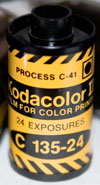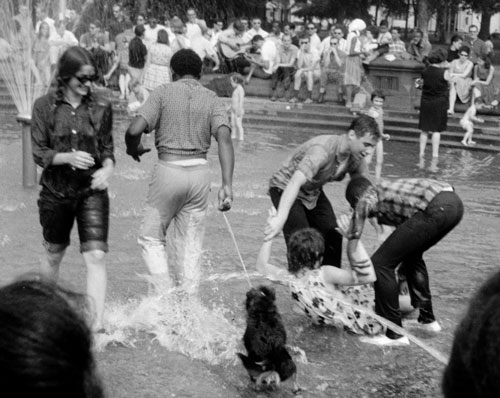2007-01-10

|
In 1962 or 1963, when I was 14 or 15, I started to get interested in photography, and that meant buying an enlarger. (For those of you who have no idea what an enlarger is, think of it as a table-top slide projector that projects film negatives onto photosensitive paper.) I answered an ad in the paper for a used one, and bought it for maybe $15 or $20. I told the seller I didn't have a camera of my own yet, so he gave me the Argus A you see pictured.
I used the Argus for a year or two, and then bought the new Konica FP SLR that I mentioned yesterday. After that I lost track of the Argus. Then, a couple of weeks ago one of my sisters mentioned that she had it. She sent it back, and it just arrived.
(Last week a completely different sister sent me a completely different camera, a Leica M3. Regrettably, it never belonged to me, so it's only on loan. I'll tell you about the Leica another day. I have four sisters total, so maybe two more cameras are on their way.)
 Anyway, I started to turn the rewinding knob to see what would happen, and I felt resistance. I had the feeling the camera was loaded. I squeezed into the hall closet, closed the door, opened the back, and felt film inside. I put the back on (it comes competely off for loading and unloading), rewound the film, took out the cartridge, and discovered an old roll of Kodacolor II (right). Of course, I had to see what was on the roll, so I dropped it off at Mike's Camera in Boulder.
Anyway, I started to turn the rewinding knob to see what would happen, and I felt resistance. I had the feeling the camera was loaded. I squeezed into the hall closet, closed the door, opened the back, and felt film inside. I put the back on (it comes competely off for loading and unloading), rewound the film, took out the cartridge, and discovered an old roll of Kodacolor II (right). Of course, I had to see what was on the roll, so I dropped it off at Mike's Camera in Boulder.
Now I'll take a brief time out from writing so I can go over to Mike's and see what's on the film, if anything. Be back soon...... OK, I'm back. Turns out nothing was on the film. Not exposed, or the shutter didn't fire, or it's just too old. Mike's didin't even charge me... great people there! Back now to the main story...
Stephen Gandy, who runs the terrific CameraQuest site, calls the Argus A "The 2nd Most Important 35 of All Time" on his Argus page (the Leica A is first), because the Argus A was the first 35mm for the masses (more about the masses shortly), and was responsible for the popularity of 35mm film. Arguses (Gandy calls them "Argi") were made in Ann Arbor, Michigan. The A was first sold in 1936, for $12.50. (Notice the Art Deco styling.) They sold 30,000 the first week! A few years later they cut the price to $10. Production stopped in 1950, but by then they had the C3, which was even more popular.
I don't know exactly when my Argus A was made, but it was between 1936 and 1941, because after that they started making improvements that my camera doesn't have. The serial number is 52035. Maybe that means it was made the second week?
There are some wonderful Argus web sites, including Hrad Kuzyk's site, where he has an detailed history of the camera and even a 76-page e-book, 35mm For The Proletariat, you can download. I've just glanced at the e-book so far, and it looks really well done. Here's my favorite paragraph in the Preface:
Finally, the use of the word "proletariat" in the title deserves an explanation. This outdated term was particularly popular in the socialist propaganda of the 1930s, when the Argus was first introduced. The members of the proletariat, also known as the proles, are the exploited working class who are forced to trade manual labor for money in order to survive. The Argus was the first 35mm camera designed to make photography affordable enough so that anyone, even members of the proletariat, would be able to purchase and use it. The use of this term does not insinuate any socialist leanings in either the author or the persons, companies, or groups mentioned in this text.
Had I known my Argus was subversive back in the 60s, I would have loved it even more.
I shot only B&W with my Argus (I think that Kodacolor II roll was my sister's), and I developed all the film myself in my home darkroom. I've recently scanned in almost all the negatives I ever took with my Argus A. The camera was definitely not an inexpensive Leica, or maybe mine never worked right. There was no rangefinder. Instead, the lens had two positions: near and far. None of my pictures look really sharp, certainly not by today's standards, or even the standards of 1936 for good cameras. Maybe the fastest shutter speed, 1/200, wasn't fast enough. If I get a chance, I'll put a roll in and shoot some pictures with a tripod.
Here's probably the best picture I ever took with my Argus A. It was taken at Washington Square Fountain in New York during the Summer of 1962 or (more likely) 1963. The negative is poorly exposed and dirty, but I fixed it up pretty well in the Photoshop CS3 beta I've been using. I didn't have Photoshop CS3 in 1963.

|
Click image for full-size picture. |